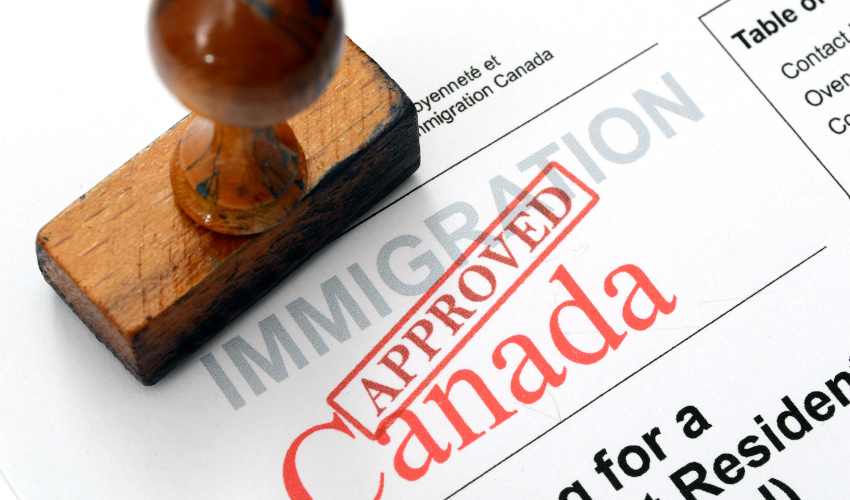Canada Work Permit Application – Canada Issued A Historic Number In 2022
IRCC processed more than half a million more work permits in 2022 than the previous year. Approximately 756,000 work permits were processed in 2022, compared to 215,000 in 2021.
In 2022, a record 608,420 Canada work permit application were proceed and issued, 472,070 under IMP work permits and 136,350 TFW from all over the world, hitting previous historical records. If we look at the percentage of people who got their work permit through the IMP, it would be around 77%. Mexico, India, & Guatemala are the top three countries for workers under the TFW category, holding 58% of the total. In the IMP work permit category, India, Ukraine, and France are ahead of the others, holding 53.5% of the total.
What has IRCC done to reduce the backlog?
To reduce the backlog of temporary residence applications in their inventories, including those for the worker, IRCC is acting. The Actual backlog of Canada work permit application in January 2022 was 48% compared to 26% in January 2023.
- According to the IRCC statistics, Canada is now processing more worker visa requests than before the outbreak. These are the steps taken by IRCC to reduce backlog:
- Applications from workers in critical industries such as transportation, agriculture, and health care were given priority by IRCC since these sectors require the most significant labour to safeguard Canadians’ health and maintain a sufficient supply of food.
- For applicants following the temporary resident pathway to permanent residence and those whose post-graduation work permits are about to expire, the IRCC announced the extension of work permits.
- Regardless of when they arrived in Canada, IRCC expanded a public policy to allow all visitors with legitimate temporary resident status to apply for an employer-specific work permit.
- With a 20% increase in applications, IRCC introduced the 2023 International Experience Canada (IEC) programme.
- Family members of temporary foreign employees are now eligible for Canada work permits, according to the IRCC.
Work Permits Issuance At A Glance (2015-2022)
Source: IRCC Statistics and Open Data
| Temporary Foreign Worker Program (TFWP) work permit holders (LMIA-BASED) by country of citizenship and year in which permit(s) became effective, January 2015 – December 2022 | ||||||||
| Top 10 Countries | 2015 | 2016 | 2017 | 2018 | 2019 | 2020 | 2021 | 2022 |
| Mexico | 22,950 | 25,905 | 27,175 | 28,855 | 30,885 | 27,150 | 32,895 | 41,235 |
| India | 1,955 | 3,255 | 5,065 | 7,375 | 11,955 | 10,120 | 10,055 | 19,135 |
| Guatemala | 5,680 | 6,505 | 8,240 | 9,810 | 11,925 | 12,280 | 15,400 | 18,645 |
| Philippines | 11,685 | 12,300 | 9,150 | 8,750 | 10,085 | 6,880 | 9,950 | 12,750 |
| Jamaica | 8,550 | 9,460 | 9,435 | 10,200 | 10,320 | 9,065 | 10,125 | 11,110 |
| Korea, Republic of | 875 | 1,375 | 1,890 | 1,955 | 2,555 | 2,160 | 1,935 | 2,190 |
| France | 1,390 | 1,180 | 890 | 915 | 1,145 | 1,065 | 1,800 | 2,150 |
| Vietnam | 30 | 60 | 170 | 330 | 485 | 715 | 1,000 | 2,030 |
| Tunisia | 45 | 35 | 55 | 180 | 590 | 620 | 1,125 | 1,635 |
| China, People’s Republic of | 550 | 855 | 1,050 | 935 | 1,335 | 1,005 | 1,295 | 1,565 |
| Iran (Not at this ranking) | 30 | 55 | 60 | 125 | 210 | 200 | 270 | 455 |
| Total unique persons | 72,965 | 78,450 | 78,470 | 84,000 | 98,030 | 84,105 | 103,340 | 136,350 |
Immigration Streams | Work permits issued of the total |
Agriculture workers | 51% |
Other temporary foreign workers with an LMIA | 46% |
Live-in caregivers | 2% |
Caregivers | 2% |
Source: IRCC Statistics and Open Data
International Mobility Program (IMP) work permit holders (LMIA-EXEMPT) by country of citizenship and year in which permit(s) became effective, January 2015 – December 2022 | ||||||||
Top 10 Countries | 2015 | 2016 | 2017 | 2018 | 2019 | 2020 | 2021 | 2022 |
India | 20,575 | 30,675 | 34,310 | 55,325 | 86,830 | 99,385 | 124,795 | 149,140 |
Ukraine | 1,170 | 1,645 | 1,660 | 1,765 | 1,925 | 1,410 | 1,460 | 78,795 |
France | 18,300 | 17,605 | 22,350 | 23,430 | 25,305 | 14,850 | 17,395 | 24,645 |
China, People’s Republic of | 15,150 | 21,420 | 20,835 | 21,860 | 22,480 | 19,945 | 21,515 | 20,350 |
United States of America | 27,515 | 28,080 | 27,610 | 26,525 | 26,790 | 13,015 | 16,060 | 18,375 |
Philippines | 5,895 | 5,460 | 4,205 | 4,805 | 6,045 | 6,055 | 11,505 | 17,420 |
United Kingdom and Overseas Territories | 8,815 | 9,755 | 10,190 | 11,190 | 12,225 | 5,405 | 7,130 | 11,265 |
Hong Kong SAR | 510 | 760 | 795 | 775 | 965 | 820 | 4,005 | 9,570 |
Mexico | 2,335 | 2,660 | 3,085 | 3,745 | 4,825 | 3,880 | 6,620 | 9,560 |
Iran | 1,100 | 1,745 | 1,820 | 2,700 | 4,540 | 4,540 | 7,905 | 9,210 |
Total unique persons | 176,280 | 207,565 | 222,720 | 253,365 | 303,545 | 240,515 | 310,660 | 472,070 |
Immigration Streams | Work permits issued of the total |
Medical residents and fellows, and post-graduate employment applicants | 36% |
Charitable or religious workers | 29% |
Other IMP participants | 8% |
Spouses of skilled workers | 5% |
Post-doctoral Ph.D. fellows and award recipients | 4% |
Intra-company transfers | 2% |
International Experience Canada (IEC) | 2% |
Canadian Provinces | Number of Work Permit holders |
Ontario | 221,280 |
British Columbia | 102,845 |
Québec | 89,765 |
Alberta | 43,550 |
Manitoba | 19,765 |
Nova Scotia | 12,645 |
Saskatchewan | 10,550 |
New Brunswick | 9,640 |
Newfoundland and Labrador | 4,210 |
Prince Edward Island | 3,840 |
Northwest Territories | 260 |
Nunavut | 60 |

Understanding TFWP and IMP
Canada work permits will be issued by an IRCC (Immigration, Refugees and Citizenship Canada) officer that enables a Temporary Foreign Worker (TFW) who is not a Canadian citizen or a permanent resident to live and work in Canada for a specified time. You can get a work permit under two major work permit programs:
The main difference is that the IMP allows Canadian employers to hire TFWs on Canada Work Permits without requiring an LMIA (Labour Market Impact Assessment). On the other hand, the regular TFWPs require employers to test the Canadian labour market to prove a labour shortage by receiving an LMIA and consequently applying for Work Permit.
The TFWP is pointed at addressing labour shortages in Canada. Employers must conduct the LMIA process to prove to ESDC (Employment and Social Development Canada – Service Canada) that hiring a foreign worker is due to the lack of appropriate workers. The issuance of positive or neutral LMIA by ESDC will confirm that hiring a foreign worker will have no negative impact on the Canadian labour market. Then the employer provides a copy of positive or neutral LMIA to the foreign worker so that they can submit it along with their work permit application to the IRCC. Once their work permit application is approved, the employee can come to Canada to start working.
By contrast, the IMP helps Canada’s social, cultural, and economic objectives, so there is no requirement for a labour market test. Many IMP work permits are a result of Canada’s free trade agreements. For instance, the Canada-United States-Mexico Agreement (CUSMA, formerly NAFTA) is a prominent free trade agreement allowing U.S. and Mexican citizens to work in Canada without an LMIA. The spouses and the common-law partners of international students, PGWP holders, and skilled workers in Canada are eligible to get open work permits under the IMP, allowing them to accept any job offer in Canada regardless of employer, occupation, or location.
On average, Canadian employers hire around 100,000 foreign workers yearly under TFWP and 300,000 under IMP.
Canada work permit Applications Eligibility
A job offer from a Canadian employer and a positive LMIA or proof that is LMIA-Exempt. The Canada work permit application must submit completely that shows they meet the requirements of the IRCC, including the following:
- Meet the required experience and education to fill the position.
- Satisfy the IRCC officer that they will leave Canada after the authorized stay.
- Evidence of enough money to support themselves and their family while in Canada.
- Respect the law and have no criminal record.
- Be in good health and have a medical exam, if needed.

Why is Canada's work visa refused?
There is one thing you should know there are many reasons for Canada work visa refusal, depending on various cases, the type of work visa you applied for, and the country of your citizenship. When examining the work permit applications, the IRCC visa officers’ immediate question is: “Will the applicants return to their home country after the duration of their intended trip to Canada?” So, if applicants fail to convince the IRCC officers that they will exit Canada at the end of their authorized stay or if they have grounds to believe that the applicants may overstay in Canada, then the TRV application will most likely get refused. The second main reason is that the Visa Officer believes you could not adequately perform the work in Canada (The job offered to you).
How can I avoid a Canada work visa refusal?
The work permit application is one of the most complex applications to get approved. It requires detailed personal and family information and many documents to strengthen and support your application. It is essential to prepare a solid application, as the immigration officers can decide based on the information provided. The Canada work permits approval or refusal process doesn’t require you to an interview, as the IRCC’s screening process is conducted by document verification of your application.
What are my chances of getting a Canada work visa?
In recent years, obtaining Canadian work permits has been a dream for many students. Although Canada has been a welcoming country for immigrants for many years due to its geographical conditions, area, and small population, the refusal rate of Canadian Work visas has increased in recent years due to the lack of applicant knowledge of Canadian immigration regulations.
The Canadian government has invested much in the last few years to regulate immigration services. It finally created the CICC (The College of Immigration and Citizenship Consultants), which licenses and regulates Canadian immigration and citizenship consultants in the public interest, whether they practice in Canada or abroad. It protects the public from any possible immigration fraud resulting from ghost consultants worldwide, benefiting valuable immigrants who seek to increase their approval rate to get Canadian visas by using professional services.
Canada Work Permit Application FAQs
Employer-specific work permits allow you to work in Canada under certain restrictions, such as your potential employer’s name, the length of your workday, and where you can work (if applicable).
Typically, a work permit application must be submitted before entry. Foreign nationals may occasionally apply at the border. The IRCC allows visitors to temporarily apply online for a Canada Work Permits from within Canada because of COVID-19.
In Canada, there are two categories of work permit programs:
- Temporary Foreign Worker Program: To receive a work permit, a foreign person must complete a Labour Market Impact Assessment (LMIA).
- International Mobility Program: To get a work visa, a foreign national is not necessary to submit an LMIA.
The USMCA (United States-Mexico-Canada Agreement) has made getting Canada work permits simpler for Americans and Mexicans. There are still conditions that must be met, though.
As a temporary worker, there is no predetermined maximum period that you can work in Canada. The job offer from your employer determines how long you can work. If your company needs to obtain one to recruit you, the period specified in your Labour Market Impact Assessment.
Applicants should pay $100 for the open permit holder cha and $155 for the work permit.
- Make a request online from outside of Canada.
- Finish the application, which must be accompanied by a medical examination (if necessary).
- After submitting your application, provide the results of your biometrics within two weeks (if needed).
Yes, your employer may engage a temporary employee like you under the International Mobility Program (IMP) without first conducting a Labour Market Impact Assessment (LMIA).
You are welcome to remain in Canada while IRCC reviews your request for a new work permit. This status is referred to as maintained status.
- Identity documentation. A passport or other travel document in good standing that allows you to return to the nation or territory it was issued.
- Evidence of employment within Canada.
- Evidence of a connection.
- Other paperwork.

How Can We Help You?
At ARNIKA, we help you to find the most tailored strategy to achieve your immigration goals. From filing the immigration forms to guiding you through supporting documents, we take care of it all. We can assist you entirely or partially based on our different packages. We can advise you professionally regarding the required personalized supporting documents to increase the chance of your approval and, finally, submit your application to IRCC on your behalf as an authorized representative. If you want to discover how the RCIC can help you, the first step is to complete the Assessment Form (To detail your personal, educational, and employment information) available on the site.



